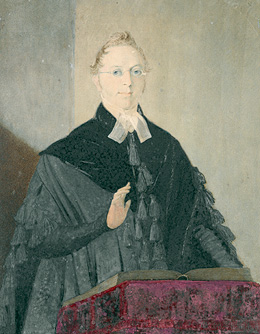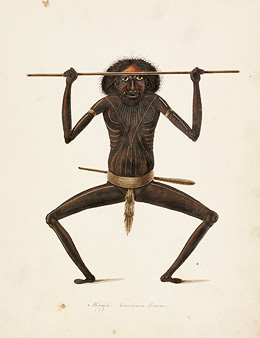Missionary Translations
John Dunmore Lang
The Reverend John Dunmore Lang emigrated to Sydney in 1823 from Scotland and was the Colony’s first Presbyterian minister, establishing Scots Church in Sydney in 1826. Lang was active in promoting free emigration from Britain to the colonies, especially Protestant emigration. His belief was that well chosen migrants would produce a moral reformation in New South Wales. He lobbied extensively for the ending of convict transportation to the Australian colonies.
Lang was elected to the Legislative Council in Sydney in 1843 and served on nine select committees. He argued for the separation of Port Phillip and Queensland from New South Wales and believed fervently in the necessity of local self-rule. He encouraged a sense of national identity and looked to a time when all the Australian colonies would be united in one political federation.
The vocabularies included in the Rev. Lang's papers include words from Aboriginal languages in New South Wales, encompassing the Sydney region and Argyll county, incorporating Goulburn and bordered by Lake George.
Also included are words from the communities around the Endeavour River near Cooktown in Queensland, including a further reference to the word, 'kangaroo'. Language from King George's Sound in Western Australia was also recorded.
Transcription: John Dunmore Lang - Papers, 1823-1887, Vol. 9, Personal and Miscellaneous, MLMSS A2229
[Page 1]
Words taken from One of the Natives of Argyll
| Ne | Yes |
| Yimmit ganta | hungry |
| Pente ganta | very full |
| Gar ganta | cold |
| Mini ganta | warm |
| Garbinaba | bad |
| Yimama murry | very good |
| Cobia | the head |
| Goulbo | the ancle |
| Gyenn Gyerm | the stars |
| Gago | the moon |
| Buggri | the sun |
| Cunie | a house |
| Mini | a black fellow |
| Corobang | fine, good-looking |
| Ca-boni | beautiful |
| gau-gau | by and bye |
| Cama | a spear |
| bugry | well done |
| tuggra | cold |
| Aingo | a god |
| matong | brave |
| girn | afraid |
| walla | you |
| moggra | a fish |
| bell | don’t |
| Moungâ | this morning |
| Moungo | tomorrow mong |
| Minimi | little |
| Pickineni | a child |
| Gin | a wife |
| pente bull | a murry tuck out |
[Page 2]
| Yummut ganta walla | Are you hungry |
| Pentiganta mi | I am quite full |
| Garganta walla moungâ | Are you cold this morg |
| ne, murry tuggra | yes very cold |
| Murry miniganta | very warm |
| Aat caboni Cunie | that’s a beautiful house |
| O murry yemema murry | O very very fine |
| bill yemema murry dat | That’s not a good one – |
| Yimmit ganta mi | I am very hungry now |
| gau-gau-moungô | by & bye tomorrow |
| mury pentibull mi | [indecipherable] mury tuck out |
[Page 3]
A specimen of the Language of the Aborigines of different parts of the Shores of Terra Australis including Van Diemens Land
| Macquarie Harbour V.b island | |||
| Parts of the Body | Trees or shrubs | ||
| The Eyes | Nam-murūck | Banksia Australia - | Levi-lack |
| Nose | Meo-une | Corroa rufa - | Nur |
| Ears | Goun-reek | Mesembryanthenum aquilaterale} | Nu-ick |
| Hair of the head | Pipe Bipipe | Monotria lineata | Tanguou |
| beard | Rūm | Melaleuca or Teatree} | Powne Rowne |
| Teeth | Mim | Acacia sophon | Powne Rowne |
| Neck | Treek-Langaree | whose pods are eaten | |
| Arms | Yir-a-wig | by the natives when roasted} | Gur-wêêr |
| Fingers | Wy-marnock | A tree | Wy-rūin |
| Elbow | Nam-merick | A stone | Tallop-Lōne |
| Nipple | Nerri-wock | A Kangaroo | Raguo |
| Navel | Wy-tūne | skin | Lan-murnock |
| Knee | Nonē | Any vessels to carry water, thence the | |
| Toes | Peūne | glass bottles we gave them are calld, | Moke |
| ___nails | Wandit | Fire | Lōpe |
| Yes | Wā-āck or Wāck | ||
| Come here | Argār argār! | ||
King George’s Sound on the SW Coast
Lat 35 Lang 118
| Scars on the body | Naām-búrn |
| Fire woods | Go-gŏrr |
| A spear | Nam-berr, or Pege - rŏ |
| A knife (of quartz) | Tāz-ah |
| Rope | Ne-ar-ban-gŏ |
| Wood (Plank) | Yan-da-ri |
| Lips | Tār |
| Throat | Wurt |
| Thighs | Dtou-al |
| Knee |
Wonat |
| King Geo Sound contd | |
| Leg | Maāt |
| Foot | Ja-an or bangul |
| Ear | Du-ong |
| Nose | Tar-mūil |
| Head | Mā-ka |
| A porpoise | Norduck |
| Woman | Pay-dgero or Corman ? |
| Hair of the Head | Kaat |
| Come here | Cou-wāh |
| Go away | Būl-ŏ-cŏ |
| Shoulder | Dja-dan |
| A musket | Pūĕlār |
| Gum of the Ianthorrhoo or Grape tree | Parŕ-im |
| Tomorrow | Manioc |
| Surprise or | |
| Admiration} | Cāi-cāi-cāi-cāi-caigh (the last word |
| the exclamation of | lengthened with the breath |
| Goose (in our coops) | Ca-an-gan |
| Dog (spaniel) | Ti-a-ra |
| Eat biscuit | Ya-munga-ma-ri |
| A seal | Bā-al-lot |
| The Sun | Djaāt |
| Teeth | Malk grum-emera Or lock |
| Water | Ba-doō (suspected to be borrowed from Colonial |
| vessels touching at K.G. Sound) | |
| Beard Ny-a-nuck | |
| Cheek | Ny-a-luck |
| Mouth | ta-lah |
| Tongue | Thalit or Darlin |
| Arm | Wornuck |
| Nails | Perah |
| Finger nails | Peah-mai |
| Toe nails | Perah-kah or Pera-kēa |
| Nipple | Bepep |
| Belly | Cob-bull or ko-pul |
| Posteriors | Wallar-kah |
| Privates | Yaw d-wit |
[Page 5]
King George Sound contd| Kangaroo | Be-an-gŏ |
| a Frog | Tōke |
| Throwing stick | Me-a-ra |
| Stone Hammer | Ku-o-it |
| Eye | Meāl |
| Toes | Kea or Kian |
| Navel | Beāl |
| Elbow | Guo-gong |
| Back | Go-ong |
| A Hawk | Bar-le-rot |
| A Shark | Margit |
| Band of the wosted | |
| of kangaroo fur, forming | |
| a Girdle round their loins} | Noodle-but |
| A fish of a particular kind | Wallah |
DL The above specimen was obtaind from a native, who, on the visit of His Majesty’s Sloop Bathurst to King geo Sound in 1822, lived entirely on board the vessel and became quite attachd to the crew, with whom he messd daily during the stay of Captain King at Anchor, which exceeded 2 weeks - It may therefore (when associated with the Natural Intelligence and quick Comprehension of the Aborigine) be concluded very correct. –
Endeavour River East Coast
within the Tropic
Lat 15o.27 So ---- Long 145o 10 East
The short period of Communication with the natives that in the present day, inhabit the shores of this River, altho’ it did not enable us to form a vocabulary of their language, was nevertheless sufficient to allow us to gather a few words from those offensive mischievous savages, who to our surprize did not at all recognize, as a term of their Language, the Word “Kangaroo”
[Page 6]
Endeavour River
which was supplied by themselves of this particular part of the Coast [part of page missing] ago, to the Animal, so generally known by that appellation in Europe and of which the first specimen that was scientifically examined was shot at the River in 1770 on the Discovery of New South Wales by the Immortal Cook, which was described by the eminent naturalists Sir Joseph Banks & Dr Solander, who accompanied that memorable Voyage of Discovery. – We (in 1820) learnt that the present aborigines call the kangaroo of those forest hills,
Minuar, Menuār or perhaps as some pronounced it Mānia - The Inference drawn from this circumstance is that probably the present Inhabitants were themselves or their parents from the Interior of the Country originally, that upon making a descent upon the Coast they destroyd the whole of the tribe occupying it, and taking possession of their range of District, introduced of course their own particular Dialect - of which the following specimens –
| The Eye | Caree or Me-ell | Canre, Maragah | |
| Nose | Ewerda or Pot-eer | (A tree scoopd out) | |
| Ear | Milkah | Huts Yer-ka | |
| Teeth | Molyear | Quail | Karr-kee |
| Finger | Mun-galbah | Feather | Teer |
| Elbow | Yer-wee | Pigment | Doparr |
| Knee | Bongo | Hair (hd) Morroor | |
| Navel or | Tolpora or | beard | Wal-larr |
| Nipples | Coyoberra | ||
| Go alone | |||
| Go on or | |||
| Go away | Tat-ee or Tartee | ||
| a Friend |
It-chew or Hi-tchew |
Magil, Corroboree dance [ca 1819-20], attributed to R. Browne
Watercolour drawing, SV/147


